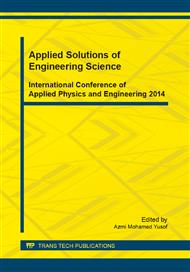p.68
p.73
p.81
p.95
p.100
p.106
p.111
p.118
p.123
Bonding Strength of Expanded Polystyrene (EPS) Beads Enhanced with Steel Fiber in Reinforced Lightweight Concrete (LWC)
Abstract:
Lightweight concrete (LWC) is one of the favourable concrete to be used as it has low density with acceptable high strength, high durability, and toughness. In order to produce LWC, it is required special material such as expanded polystyrene (EPS) beads and steel fiber to be added into the design mix concrete. As known, EPS beads have zero strength. Meanwhile, the significant of steel fiber is to reduce micro and macro crack propagation. Therefore, pull out test were carried out to measure the bond strength between reinforcement bar and three series of concrete mix design which are normal concrete, EPS-LWC and EPS-LWC enhanced with steel fiber. Concrete adhesion and bearing deformation of reinforcing bar against the concrete are the two main mechanisms that influence the strength of bond in the steel reinforced concrete. Deformation will increase when the bonding stress increase. Normal concrete series shows the higher average bonding stress which is 531.22 kPa compared to others series concrete mix. Meanwhile, bonding stress of EPS-LWC mix is 174.54 kPa which is higher than EPS-LWC enhanced with steel fiber mix. Even though the present of the steel fibre can increase the strength of the LWC, but it effects to the bonding strength between reinforcement steel rod and concrete. There are two improtant factor in bonding determination which are volume fraction and aspect ratio of the steel fiber. Segregation will increase when the aspect ratio of steel fiber increased. Besides, the workability becomes low. This present study used types of hooked end steel fiber with 60 mm length and aspected ratio is 0.75. While the size of the cylindrical is 300 mm x 150 mm. The position of the steel fiber in the specimens is too compact and presenting the air voids. Consequently weaken the bonding strength between concrete and reinforcement bar.
Info:
Periodical:
Pages:
100-105
Citation:
Online since:
October 2014
Authors:
Price:
Сopyright:
© 2014 Trans Tech Publications Ltd. All Rights Reserved
Share:
Citation:


